By Kevin Dockery
In 1965, SEAL Team One began receiving the M79 to arm their direct action platoons in preparation for deployment to Vietnam early the next year. The M79 was well received by the Teams and quickly became a major source of firepower.
Initially with the Teams, the primary round of ammunition used with the M79 was the M406 high explosive round. The large, heavy, projectile of any of the 40 mm rounds could be easily seen by the gunner as they lobbed through the air. Being able to actually see the projectile in flight was a bit disconcerting at first, as the projectile’s large size and low muzzle velocity made it appear the wobble through the air without the ability to hit anything accurately. Confidence with the new weapon came with training. SEALs during pre-deployment training would practice extensively with their weapons, M79s among them. Even with its high, arcing trajectory and apparently slow travel, grenadiers soon learned that the 40mm grenade could be almost amazingly accurate.
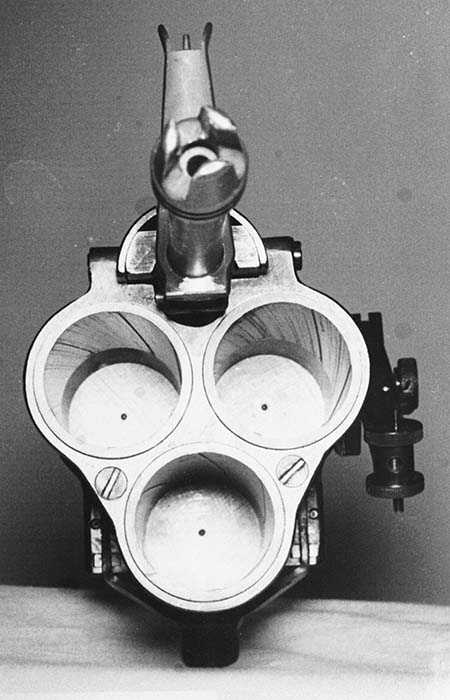
Experience with the weapon is what developed skill in an M79 grenadier, and the Teams made certain some of that experience was with their men right from the start. As part of their combat preparation, SEALs would spend hours on the range practicing with their chosen weapons. A skilled M79 grenadier could often drop a grenade right onto a target that was 150 meters away by simply pointing his weapon and looking along the barrel. This kind of shooting was considered instinctive, very quick, and didn’t employ the fairly complex rear sight of the M79 at all. When using the sights and aimed carefully, the accuracy of the M79 was such that a good operator could consistently drop grenades into a garbage can at 150 meters.
Working against the accuracy and effectiveness of the M79 was the fact that it was a dedicated, single-shot weapon. Any SEAL who carried an M79 was very limited in what he could do with the weapon during a close-in encounter of less than 15 meters. The minimum arming range of the grenade, combined with its bursting radius, made the round ineffective and dangerous when used close-in during a sudden eyeball-to-eyeball encounter with the enemy.
becomes a non-issue and the SEAL would open fire with whatever he had in his hands. When a 40mm grenade struck a target in an unarmed condition, it would still act as a very large bullet. A dead VC struck with an unexploded 40mm grenade might become a problem for explosive ordnance disposal, but the SEAL would still be around to report the incident.
Prior to the SEALs sending direct action platoons to Vietnam, Marine and Army units had been in combat in Southeast Asia and had reported the drawbacks of the M79 for close-in combat. New rounds were developed for the M79 and sent over to Vietnam for combat testing. The first of the close-combat rounds for the M79 was a flechette round loaded with 45 finned steel flechettes carried in a plastic sabot. The 10-grain flechettes resembled sharp finishing nails with fins stamped into the head and were effective immediately after leaving the muzzle of the launcher.
When fired, the plastic sabot holding the bundle of fletchettes would break away soon after the projectile left the muzzle of the weapon and the flechettes themselves would spread into a widening pattern. But, as with most of the small-arms flechette loads used in Vietnam, the little finned needles were not stable at the muzzle of the weapon and usually weren’t flying straight and point first until they had traveled about 15 to 30 meters through the air. Close-in, as many as half the flechettes would hit a target sideways or backwards as point on, severely limiting the effectiveness of the round.
Two types of buckshot round were developed for the M79 in the 1965-66 time period to replace the fletchette load. The XM576E1 and XM576E2 rounds were both loaded with #4 (0.24 inch) hardened buckshot. The two cartridges differed in the plastic sabots that were used to launch the buckshot payloads. These rounds began arriving in Vietnam during the SEAL’s first deployments but were not widely available.
Higher command thought the new rounds for the M79 may have too short a range and be ineffective because of that. SEALs in the field did not hold such an opinion and thought highly of the new ammunition. The XM576E1 round was not as effective as the E2 design, which was later adopted as the M576 Multiple-projectile round, but both rounds turned the M79 into a very large shotgun. One of the reasons shotguns were so popular among the SEALs was that the buckshot loads had a great deal of stopping power, especially at close range. Flechette loads, though lethal, didn’t transfer their energy into the target efficiently and never had the knock-down power of buckshot.
With the new multiple-projectile rounds, the M79 became effective at close range. But the basic weapon was still a single-shot design. Once the M79 had fired its round, the grenadier was out of the action until he had reloaded. In the sudden combat environment of the SEALs, this situation could easily lead to men being killed because they had an empty weapon. Without there being any way to speed up the reloading of an M79, SEAL grenadiers simply took to carrying more than one weapon. In the US Army and Marine Corps, grenadiers were normally armed with an M1911A1 pistol in addition to their M79, SEALs preferred considerably more firepower.
Ammunition counts were always high when SEALs went into combat. The larger the SEAL, the more ammunition he would carry. Though the individual round count for 40mm ammunition might be low, the rounds themselves were fairly large and each weighed about half a pound. Depending on the mission, a SEAL grenadier might carry a very heavy load of 40mm grenades along with his additional equipment.
Development of new ammunition types was considered a primary means of increasing the usefulness of the M79 in general. Literally dozens of new rounds were experimented with during the course of the Vietnam war. Some of the rounds, such as the XM576E2, eventually reached standardization, others never went to combat and were only produced in small number for testing. From the very earliest operations of the SEALs in Vietnam, new types of 40mm ammunition was desired and obtained whenever possible.
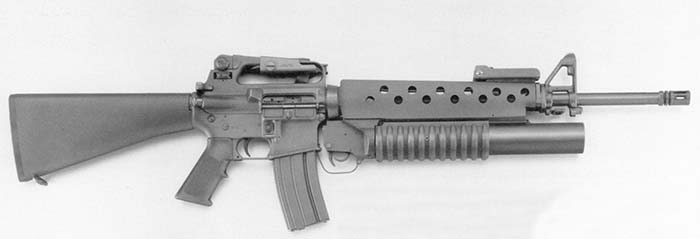
•Excerpt from SEAL Team Two, 2nd Platoon’s Vietnam operations, 30 January to 30 May 1967
Weapons and Equipment
6. If flare rounds and canister rounds were available for the M-79, the weapon’s versatility would be increased tremendously.
7. Mk 8 Very pistol rounds can be fired from the M-79.
The primary mark against the M79 was still the fact that the weapon was single shot. That had been a concern back in the mid-1950s when the design was first considered. The relatively low recoil of the 40mm ammunition family, combined with its low firing pressure, allowed another approach to solving the single-shot problem.
In September, 1964, Karl Lewis and Robert E. Roy applied for a patent on a grenade launcher attachment they had designed for Colt Firearms. By October 1966, the patent was granted but Colt had already been marketing the new weapon since 1965 as the CGL-4 (Colt Grenade Launcher), part of their CAR-15 weapons system. The CGL-4 could be mounted underneath the barrel of an AR-15 (M16E1) and operated independently of the rifle. The CGL-4 had its own controls and sighting system and used the rifle solely as a support and to supply a buttstock for firing.

To mount the CGL-4 on a rifle, the standard handguards would be removed and the CGL-4 clamped in place on the barrel. A new handguard would be placed on the barrel of the rifle to protect the operator and the grenade launcher would be ready for use. As long as there was sufficient barrel length, a CGL-4 could be mounted on any of the AR-15/M16 weapons including the short CAR-15.
A small pistol grip underneath the CGL-4 allowed an operator to unlock and slide the 40mm barrel forward, automatically extracting and ejecting any fired casing that might be in the chamber. Slipping a loaded round into the barrel and using the pistol grip to pull the barrel shut and lock it in place was all that was necessary to load the CGL-4.
A large knob on the rear of the CGL-4 receiver would be drawn back with the fingers to cock the weapon. A trigger bar extended down the right side of the supporting rifle and ended just in front of the trigger guard. Extending the end of the trigger and rotating it in place put the trigger of the CGL-4 just below the trigger of the supporting rifle. The dual trigger allowed the operator to fire either the M16 or the CGL-4 by simply moving his finger to the proper trigger.
The US Army found the CGL-4 a possible “off-the-shelf” answer to the limited firepower of the M79 in 1966. With minor modifications, the CGL-4 went into limited production in November 1966 as the XM148. Both the US Army units in Vietnam and the Navy SEALs received the new launchers in early 1967. Now for the first time, a weapon was available that had both a point target effect (the rifle) and an area target effect (the grenade launcher). The concept was new and reactions from the men in the field were carefully examined. For the SEALs, this reaction was enthusiastic.
Though the XM148 was well received by the SEALs, they were not blind to the drawbacks of the weapon. The XM148 was a lot more fragile than the simple M79, and had a great deal more parts to get out of order. There was no guard for the XM148’s trigger bar that extended down the right side of the carrying rifle. Any piece of brush, equipment, or even a finger that got between the trigger bar and the receiver of the rifle would push the bar out and jam the XM148 so that it couldn’t be cocked. In addition, the bare trigger bar could hang up on some material during a crawl and fire the XM148 if the weapon was cocked and the safety off. It was this drawback that caused the recommendation to go out that the XM148 could be carried with a round in the chamber, but that the weapon should not be cocked until just before use.
The final Army report on the XM148 was written in May, 1967. A number of the Army users liked the XM148 but the weapon was found to be too fragile and unsafe for general issue. The reporting team concluded that “the XM-148 in its present configuration is unsatisfactory for further operational use in Vietnam.” Recommendations were that the XM148 be removed from service until another design was available. By the fall of 1967, all of the Army’s XM148s had been turned in. The SEALs found the effectiveness of the weapon offset the bad parts of the design and retained theirs until the end of the Team’s involvement in Vietnam.
The XM148 had some unusual aspects to its action that were discovered and used by many of its operators. The sear lever of the XM148 was exposed at the rear of the receiver to the weapon. Operators in both the Army and the SEAL Teams found that you could fire the cocked launcher by pressing on the upper part of the sear lever with the thumb of the left hand without letting go of the pistol grip to the M16 with the right hand. Though not officially recommended, gunners found they could move through the undergrowth with one finger on the trigger of the rifle and the thumb of the other hand on the sear bar of the grenade launcher. Either weapon could be fired immediately without changing hands.
The Teams liked the XM148, but still wanted the firepower of the grenade launcher system increased. SEAL Team One examined at least one of the Springfield Armory produced T148E1 repeating grenade launchers for possible adoption early during their Vietnam war commitment.
•SEAL TEAM ONE – COMMAND AND CONTROL HISTORY – 1967
NWC ORD TASKS…. A listing of special procurement actions completed is summarized below:
[item 9] 40 M Grenade Launcher T148[E]1
It has not been reported that the T148E1 launcher examined by SEAL Team One was ever tested in combat in Vietnam. Though an interesting approach to the semiautomatic grenade launcher problem, the action of the T148E1 was too open and vulnerable to dirt to operate well in the jungle/mud environment of Vietnam. The sliding harmonica magazine has several open chambers that would pick up dirt and debris like scoops as the weapon was moved through the jungle. The sliding operation of the magazine, along with its coil-type driving spring, would also be easily put out of action from dirt and debris. Lastly, the accuracy problem from the shot-to-shot difference in muzzle velocity had never been completely corrected and varied not only from weapon to weapon in the T148E1, but also from magazine to magazine in the same launcher.
The Navy Special Warfare Groups (Pacific and Atlantic), which included the SEAL Teams and UDTs, had been recognized as having unique problems in the field of weapons and equipment by the Navy command. The Special Operations Branch of the Naval Weapons Center at China Lake, California, was structured to address the equipment needs of the SEALs and UDTs on a very rapid basis. Non-standard ordnance and hardware required by the Teams would be acquired by China Lake, modified if necessary, and shipped out to the users as quickly as possible. When a necessary item was not available in any form “off-the-shelf”, China Lake was set up to design, develop, and put into limited production, such items as necessary. In three years of operations during the Vietnam War, China Lake put out some 375 items on a quick-reaction basis for the Teams.
China Lake looked into the question of increasing the firepower of the 40mm grenade launcher. Taking the direct approach, the China Lake engineers applied the pump-action operating principles from civilian sporting shotguns to the problem. Production of a tool-room prototype weapon was completed rapidly and the design was ready for testing and examination. The general design was considered acceptable and a small production quantity was produced at the China Lake facilities. Development of the pump-action grenade launcher was so rapid that it reportedly took longer to make a set of production drawings from the tool-room gun than it did to produce the first weapon.
The China Lake pump-action grenade launcher resembled a very large, short-barreled shotgun and retained the same range and accuracy of the M79. Considered one of the most significant small arms produced as part of the Naval Special Warfare Projects at China Lake, the pump-action grenade launcher was ready to be issued to the SEAL Teams for combat in Vietnam by mid-1968.
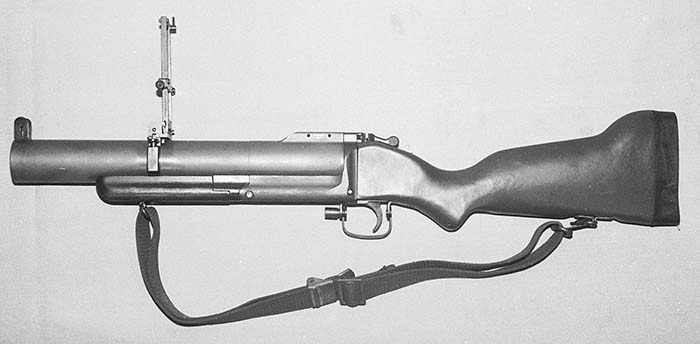
•SEAL TEAM ONE – COMMAND AND CONTROL HISTORIES – 1968,
Enclosure 3, SPECIAL TOPICS, (a) Performance of Weapons Systems
The 40MM grenade pump weapon has proven to be a good weapon and is being used by SEAL detachments in Vietnam…
Though a fairly large weapon, the 40mm pump-action grenade launcher was very well received by some of the SEALs in the Teams. Reports on the actual number of China Lake pump-action grenade launchers made are difficult to confirm. Between 20 and 30 weapons were put into SEAL hands during the Vietnam War with only one or two additional launchers going to the Marine Corps Force Recon units and Army 5th Special Forces Group. A receiver with the serial number “50” has been located but it was found in a stripped condition and may never have been assembled as a complete weapon.
The pump-action grenade launcher was one of the most successful of the shoulder-fired 40mm designs, but it was not the only one to come out of China Lake. During the calendar year 1966-1967, NWC China Lake designed and built several prototypes of a 3-barrel 40mm grenade launcher. Instead of developing a multi-shot grenade launcher that would be a dedicated weapon such as the M79, China Lake went with a much smaller design that could be mounted underneath an M16 in the same manner as an XM148. To minimize the size of the 40mm repeater, each round was given its own barrel.
The double-action firing mechanism has a trigger that fits underneath the trigger guard of the M16 in a sliding mount. The trigger bar extends along the right side of the M16 receiver in the same manner as the XM148 but with the trigger in a firm mount, there is much less probability of jamming up the bar with brush as could happen with the XM148. The fairly complex firing mechanism cocks, advances the hammer in a circular motion to the next barrel, and fires the round when the trigger is pulled once. This allows the operator to fire up to three grenades as fast as he can pull the trigger.
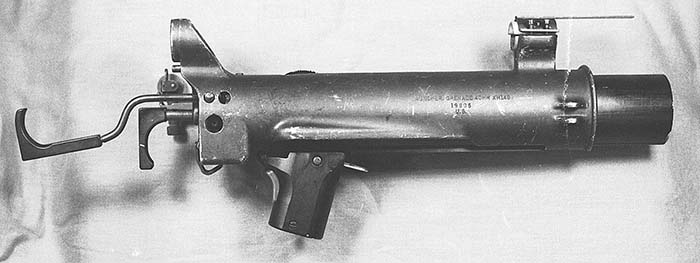
To keep the 3-barrel compact enough to fit underneath a CAR-15, the barrels are only six inches long. The short barrels are long enough for the fired grenade to pick up enough velocity and spin to arm and stabilize in flight. But the short barrels also reduced the effective range of the 3-barrel at least 15% less than that of an M79. A large housing covered the rear of the 3-barrel to protect the firing mechanism with the entire package ending up being about 4.25 inches wide.
At least one of the two or three prototype 3-barrel 40mm launchers was sent to the Marines to be tested by the Force Recon units in Vietnam. All of the other examples were sent on to the SEAL Teams for field testing. One grenadier from SEAL Team One carried an M16 with the 3-barrel launcher to test and evaluate it under combat conditions. The one operation where the SEAL carried the weapon took place on 13 April 1968 and was the only operation where this individual carried the weapon. To put it simply, the SEAL reported that the weapon was heavy, unbalanced the rifle badly, and simply did not work.
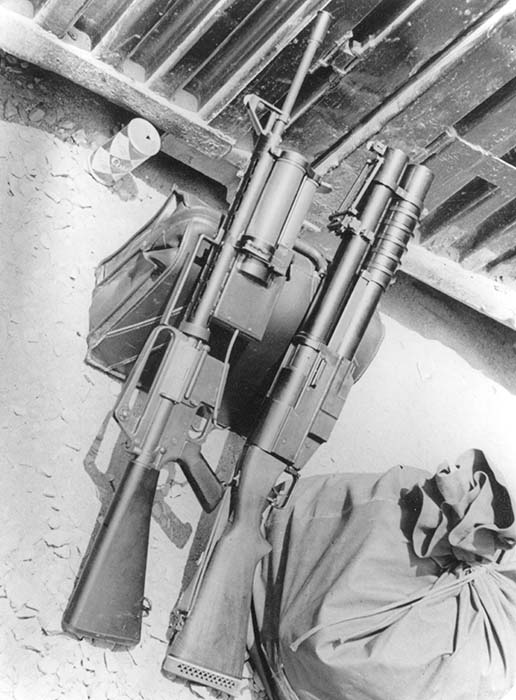
The complex firing mechanism of the 3-barrel could not stand up to the dirt and mud of the Vietnam environment. When the trigger was pulled, the weapon had as good a chance of not firing as of going off. The wide open muzzle of the three barrels were also very hard to keep free of debris when crawling through the jungle. The weapon was not adopted by the Teams and only the few prototypes were ever made.
The failure of the Colt and China Lake underbarrel grenade launcher attachments did not eliminate the idea for combining the point fire of a rifle with the area effect of the 40mm grenade launcher. The US Army put out the information to the firearms industry that they were interested in another underbarrel grenade launcher design. Seventeen different firms were spoken to during a conference on 18 July, 1967. Seven of the contacted firms reported a serious interest in the project.

AAI (Aircraft Armaments Inc.) had experience in developing a number of underbarrel grenade launchers as part of the Special Purpose Individual Weapon (SPIW) Program. AAI already had an idea in the mockup stage for a new grenade launcher in July of 1967 but the Army felt their estimated production schedules may not be possible to meet. By September, three companies, AAI, Philco-Ford’s Aeronutronics Division, and Aero Jet General had all received contracts to develop grenade launchers as part of the Army’s new Grenade Launcher Attachment Development (GLAD) Program.
The Aero-Jet design for a delayed blowback operated grenade launcher was declined by the Army and dropped from the competition. Twenty each of the Philco-Ford and AAI designs were set for testing on 1 May 1968. “Unanimously selected based on superior performance and predicted lower cost in production,” the AAI design was awarded a contract for further development on 2 August 1968. By early November of that same year, the AAI design was officially identified as the XM203 40mm Grenade Launcher.
A contract for 500 XM203 grenade launchers was awarded almost immediately after AAI received the designation for their design. By December, the XM203 launcher itself was considered complete by the US Army, though further work had to go forward on a selection of sight designs. This work was quickly completed and the construction of the first 600 XM203’s finished by AAI. In April 1969, 500 XM203 grenade launchers were sent to Army units in Southeast Asia for a 3-month combat evaluation.
The XM203 grenade launcher is a single-shot, manually operated, pump-action grenade launcher intended to be installed underneath the barrel of an M16 rifle. The barrel of the XM203 does not extend much past the front sight assembly on a standard M16 and so can be mounted underneath the barrel of any of the CAR-15/XM177 versions of the same weapon. A flip-up ladder-type leaf sight in attached to the handguard of the M16 so that the normal front sight of the rifle can be used to aim the grenade launcher. In addition, a complex quadrant sight is attached to the carrying handle of the mounting weapon for more precise long-range use of the grenade launcher.
To load the XM203, the unlocking lever above the barrel on the left side of the weapon is pressed in with the thumb and the barrel slid forward. Any empty cartridge case will be automatically ejected and the operator can load a single round of any of the standard 40mm grenades. Pulling the barrel shut locks the breech and completes loading the grenade launcher. There is no pistol grip for the XM203, the operator grabs the magazine of the M16 with his firing hand and pulls the trigger of the grenade launcher just in front of the magazine well.
The safety of the M203 is a curved metal flap that will extend in front of the trigger when on. The operator can easily move the safety forward with his trigger finger when ready to fire. One drawback of the M203 is that the spring metal trigger guard, which locks against the front of the magazine well of the carrying weapon, can be slipped up excessively during assembly and block the trigger so that the weapon cannot be fired. This is a minor, but common, error that can be corrected quickly by the operator.
The XM203 was well received by all of the units who used it. AAI was unable to build production quantities of the XM203 and Colt received the contract to produce the accepted M203 grenade launcher for all of the US services. By 1986 Colt had manufactured over 250,000 M203 grenade launchers. The SEALs began receiving the M203 grenade launcher by 1970 and have continued using the weapon to this day. After the end of the Teams involvement in Vietnam, the XM148 grenade launcher was phased out of use and replaced with the M203. In the Teams the M203 was usually mounted underneath the barrel of an XM177E2, replaced today with the M4A1 carbine.
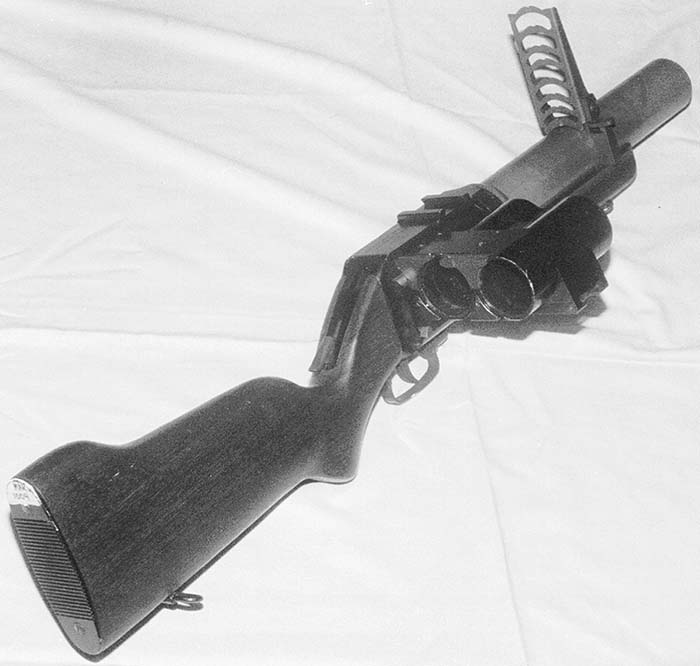
•SEAL TEAM TWO COMMAND AND CONTROL HISTORY, 1970
Enclosure 1, VI. NEW EQUIPMENT, pg 12
1. (U) During the year, SEAL Team TWO received ten new XM203 grenade launcher attachments for the M16 rifle. The XM203 replaces the XM148.
In some combat situations today, whole 16-man SEAL platoons, less automatic weapons men and snipers, have been armed with M4/M203 grenade launchers. The flexibility of the weapon, combined with its firepower, has made it one of the most successful weapons developments to come out of the Vietnam war.
Due to its greater inherent accuracy, the M79 is still found in the SEAL Teams today. The M79 is issued primarily for backup use by a SEAL who is armed with another primary weapon that cannot accept an M203 launcher.
| This article first appeared in Small Arms Review V5N7 (April 2002) |










